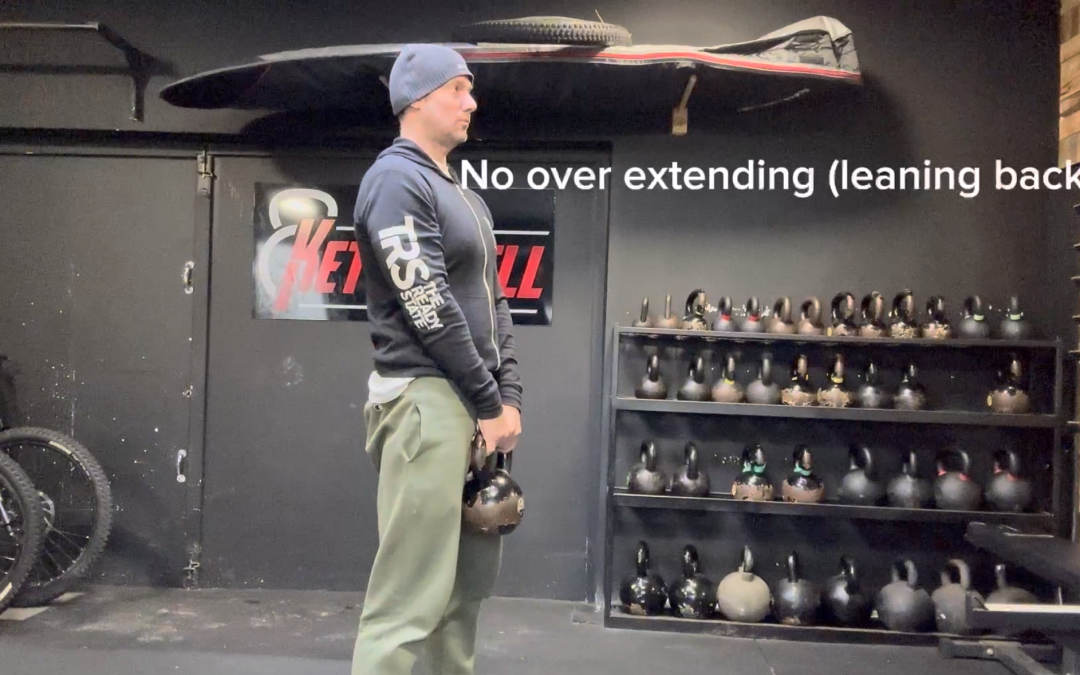Unless you’ve been involved in kettlebell training, powerlifting or olympic weight lifting you might not have come across the term “hip hinge” before.
Hopefully if you went to a kettlebell class or you used kettlebells with a personal trainer, they first taught you this essential movement pattern?
No?
Well this doesn’t surprise me!
In 15 years of teaching and coaching kettlebell exercises, the vast majority of people who came to my beginner classes and workshops who had used kettlebells before, did not know what or how to hip hinge!
Let’s fix that today!
Hip Hinge – The goal
The goal of the hip hinge is to load into your glutes and hamstrings. Hip hinging is the only way to load into these muscles with a compound exercise, whether it’s a kettlebell move, a deadlift or hip thrust variation.
When hip hinging correctly, you’ll feel a deep stretch in these muscles, and will be able to develop their strength and power.
Hip Hinge Exercises
Here’s a list of commonly performed hip hinge exercises:
- Kettlebell swings
- Kettlebell cleans
- Kettlebell snatches
- Kettlebell high pulls
- Conventional deadlift
- Romanian deadlift
- Single leg deadlift
- Hip thrust
- Hip bridge
- Good mornings
- Low bar back squat
Although the caveat on the last one is that it starts with a hinge, but then has considerable knee flexion. It’s a bit of both squat and hinge.
Hip Hinge – Step by Step.
The best exercise to learn this movement with is the KB deadlift.
Here’s the sequence of events.
- Stand with good posture, and your hips and knees locked out, holding the kettlebell close to your body on straight arms.
- Whilst maintaining good upper body posture, unlock your hips and start to shift them backwards.
- With the hips shifting backwards, let the knees unlock and come forward a little bit.
- As the hips are shifting back, the torso should be bowing forward whilst maintaining that good posture (don’t slouch)
- Use your arms to guide the kettlebell, keeping it underneath your body, not traveling out in front of you.
- You’ve finished the movement when your kettlebell has touched down, and hopefully you’re still maintaining good upper body posture and haven’t slouched or slumped over.
- To go back to the standing position, drive your hips forward and stand up to a tall posture without leaning back.
Here’s a video so you can see this in action.
Hip Hinge Recommendations for Beginners
- Practice with sets of 10, and practice often.
- Increase the load until you’re working with a weight that is somewhat challenging. The weight can be your teacher, if its heavy enough to load your muscles, your brain will understand which muscles you should be focusing on to complete the movement.
- Tune into what you can feel. You can’t effectively watch yourself in the mirror for this one so you’re searching for the feeling of a deep stretch in your glutes and hamstrings.
- Video yourself and watch it over and over, study your movement. Does your technique look the same as in the video I posted above?
- Get a coach if there’s a decent one nearby. Even one session will pay dividends in the long run.
- Join an online kettlebell group like the BKC online forum and get feedback on your technique.
- Come back to this blog post and re-read it to see if you missed some vital piece of information.
Hip Hinge – Trouble Shooting
Sometimes things aren’t so plain sailing, the fact is that the hip hinge isn’t a movement that comes naturally to us, and what else makes it challenging is it’s similarities to the squat pattern. Both have hip and knee flexion.
You’ve been squatting since you were 2 years old and so that movement pattern is very ingrained, you don’t have to think to hard (if at all) to squat.
Which leads us into the first issue I see with new trainees.
Problem One – Still Using a Squat Pattern
If you move from your knees before your hip, or at the same time as your hip, you are in a squat pattern.
Read that again.
If you move from your knees before your hip, or at the same time as your hip, you are in a squat pattern and you won’t get that big stretch into your glutes and hamstrings that we’re after.
This is a patterning problem.
You will know that this is your problem in a couple of ways. You can’t feel much of stretch in your hamstrings and/or you may feel some discomfort or loading going into your back. Check out this article for more on pain during kettlebell swings.
Or you can see that something is off when you compare your technique video to my one above. Maybe you are still too upright or you can see that the angles in the limbs don’t look the same.
Either way, here’s a video I shot showing two drills you can use today to start fixing this.
The two drills in that video should be practiced in conjunction with your regular KB deadlift.
For instance, do ten reps of one of the drills and then immediately do 5-10 reps of the KB deadlift.
Make adjustments to your technique until both movements feel the same.
Problem Two – Moving from the Spine
The second main issue I commonly see when teaching the hip hinge, is too much movement coming from the spine, rather than the hips.
The Kettlebell swing is a power based exercise, its a high velocity movement that carries over to athletics and life in general. You won’t build your strength and power if you aren’t being efficient with your movement, and moving from your spine is most definitely not an efficient way to swing a kettlebell.
Check out this video to rectify this problem.
As before, superset one of these drills with the KB deadlift and search for that stretch in your hams/glutes.
Now one caveat is that you might have really tight hamstrings, in which case you can’t move your hips back very far.
I have seen this and the fix is to obviously work on your hamstring flexibility. This might happen to a certain degree simply by getting the hamstrings stronger through KB deadlifts and eventually swings. If that doesn’t fix it, I’d recommend finding some stretches that you can do daily and work on them until resolved.
Some of my top picks would be:
Hip Hinge – Recap
The hip hinge is an essential movement pattern for kettlebell training and other strength related sports. Ideally get some in person instruction from a suitably qualified coach who can over look how you’re moving and cue you into a better position.
Its best learned via the KB deadlift, so don’t make the mistake of going straight to the swing without first practicing the movement with the DL.
If you can’t get to a coach, film yourself and compare your technique to the videos I posted above, or join the BKC Facebook group and I’ll personally give you some feedback.
If you have any questions about the hip hinge or kettlebell training in general, leave and comment and I’ll get back to you.
Good luck with your training
Pete
Owner Bristol Kettlebell club

